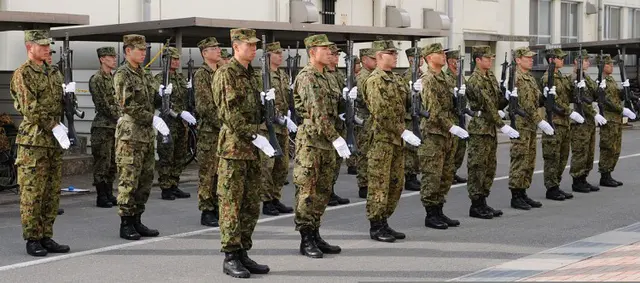Japan's Maritime Self-Defense Force (MSDF) launched a new near-billion U.S. dollar destroyer on Wednesday in Nagasaki Prefecture, on the island of Kyushu in southwestern Japan, in spite of the pacifist bindings of its constitution and a stagnant economy ill-financed for such extrinsic military hardware.
The newly-built 5,100-ton vessel called "Asahi" will go into full service for the MSDF in 2018 and its launching ceremony was attended by senior vice defense minister Kenji Wakamiya as well as around 1,300 people, local media reported.
The new destroy, sources close to the matter revealed, comprises both an electric propulsion system and a gas turbine engine, which makes for a "hybrid" like fuel efficiency powertrain, enhancing both the vessel's performance and range.
The destroy, standing at 151 meters in length and more than 18 meters in width, is also fitted with sonar technology to detect submarines, military observers said.
At a cost of 76 billion yen (735.37 million U.S. dollars) to the Japanese taxpayer, the destroyer is a small part of an increasingly rising tab for Japan's Ministry of Defense which for fiscal year 2017 has requested a record-high budget, marking the fifth annual increase since Prime Minister Shinzo Abe retook office in 2012.
The defense ministry's budget allocation is a 2.3 percent increase from this year's apportionment and will total more than 5 trillion yen, as the government, under Abe, continues to push to expand the scope of its Self-Defense Forces at home and overseas, and press for constitutional amendment to achieve this, despite widespread public and international opposition and condemnation.
The new defense budget will primarily be earmarked to upgrade missile defense systems and interceptors, for the acquisition of a new submarine with advanced surveillance capabilities, the purchase of next-generation stealth fighters, as well as to cover the costs of increased personnel.
Despite the government struggling to finance ballooning social welfare costs as the country continues to rapidly age and the population simultaneously shrink, as it grapples with public debt at more than 240 percent the size of its economy, which itself is stagnant, and is swimming against the tide in its bid to reverse decades of deflation, the government's defense spending is continuing to swell disproportionately.
The ministry's budget request also includes 105.6 billion yen on spending on an upgrade to its PAC-3 surface-to-air missile defense systems, with the ministry hoping to be able to extend the range of the missiles, as well as their precision, in time for the 2020 Tokyo Olympics.
Separately, the budget outlines plans for the ministry to obtain missile interceptor systems which are to be jointly developed between Japan and the U.S. to the tune of 14.7 billion yen and the necessary upgrades to the Aegis destroyers on which they are deployed.
The building of a new submarine with superlative surveillance capabilities, the defense ministry has said, is also being requested under the budget, with costs in this department pegged at 76 billion yen.
Other prominent hardware on the ministry's shopping list include six Lockheed Martin F-35 fighter jets, which will set taxpayer here back around 95 billion yen, as well as allocations for unmanned aerial vehicles (UAVs).
In terms of payment allocations for increased personnel, the defense ministry is seeking 74.6 billion yen to bolster forces on some of Japan's southern islands, as well as funds to set up a new amphibious unit in Nagasaki Prefecture, the same location of the launch of "Asahi" on Wednesday.
While Abe is intent on expanding the operational scope of Japan' s MSDF having made a unilateral decision at cabinet level to reinterpret Japan's pacifist constitution, and thereafter forcing controversial security legislation through parliament and into law, using his ruling Liberal Democratic Party-led coalition's majority in both caucuses, the public and international community remain staunchly opposed to its revision and the government's expanding military drive.
The constitution, which the nation remains bound by, instituted after Japan lost WWII, prohibits Japan from maintaining any war potential or for using force as a means to settle international disputes.
It also, unequivocally, decrees that the Japanese people forever renounce war.
(APD)
 简体中文
简体中文

